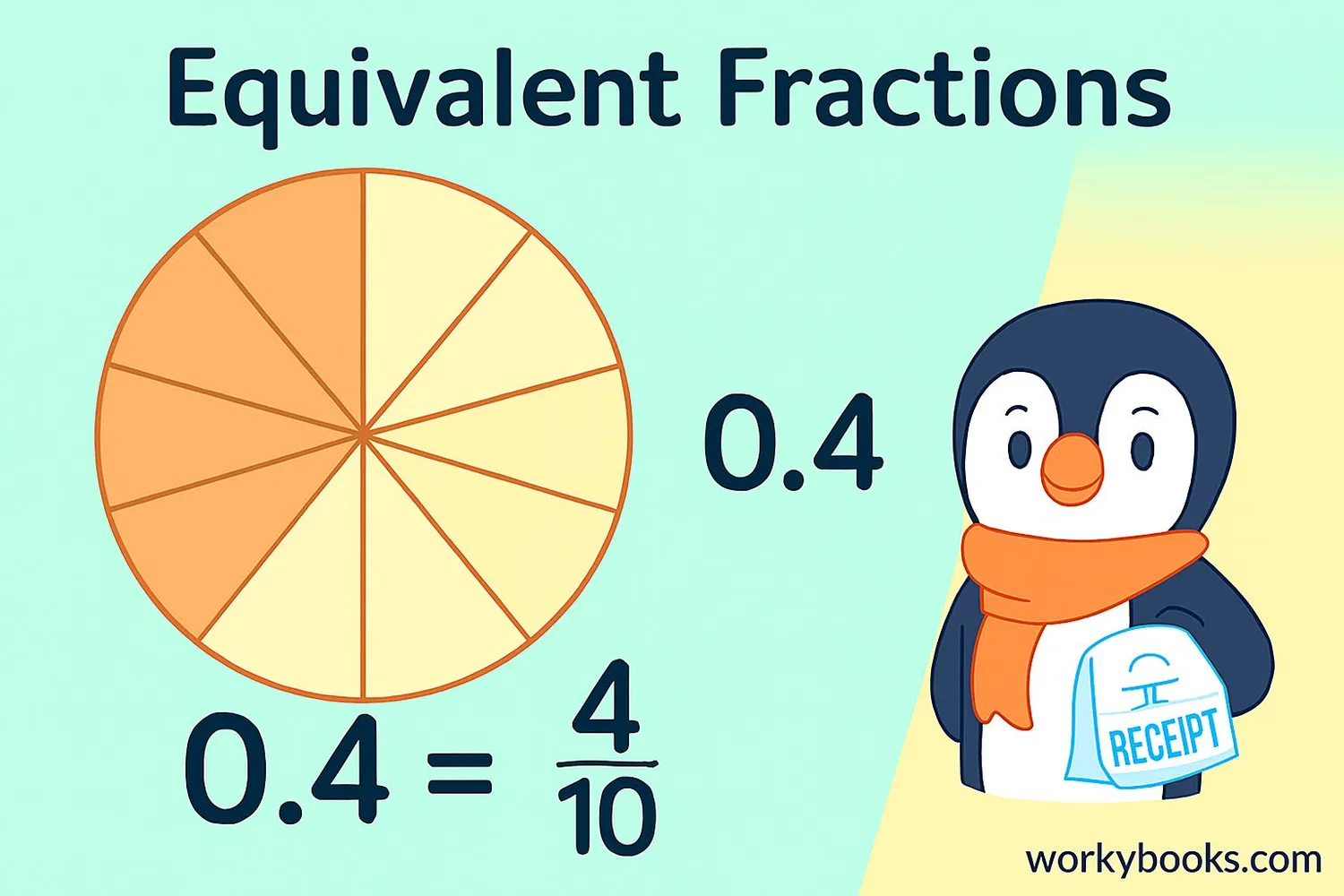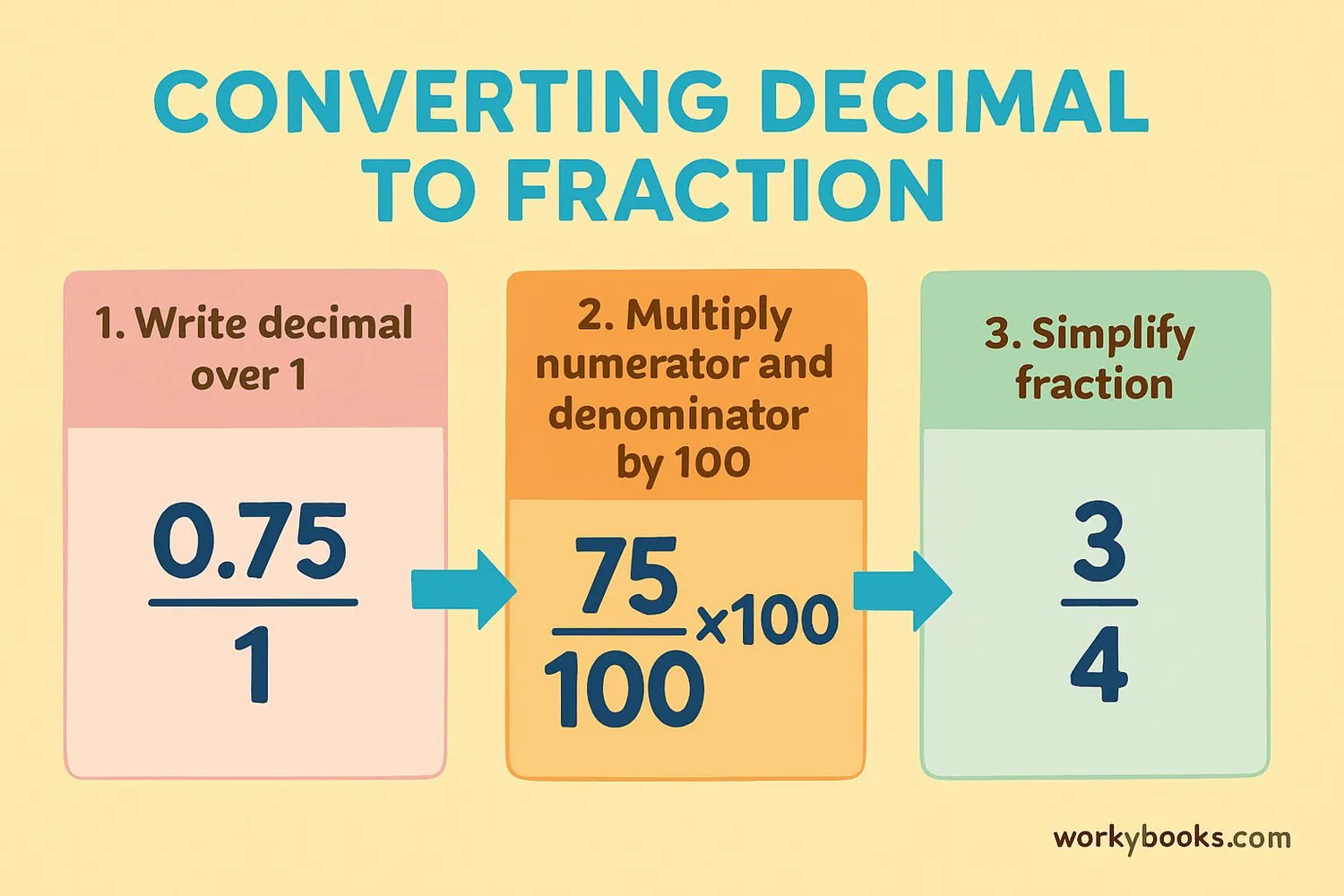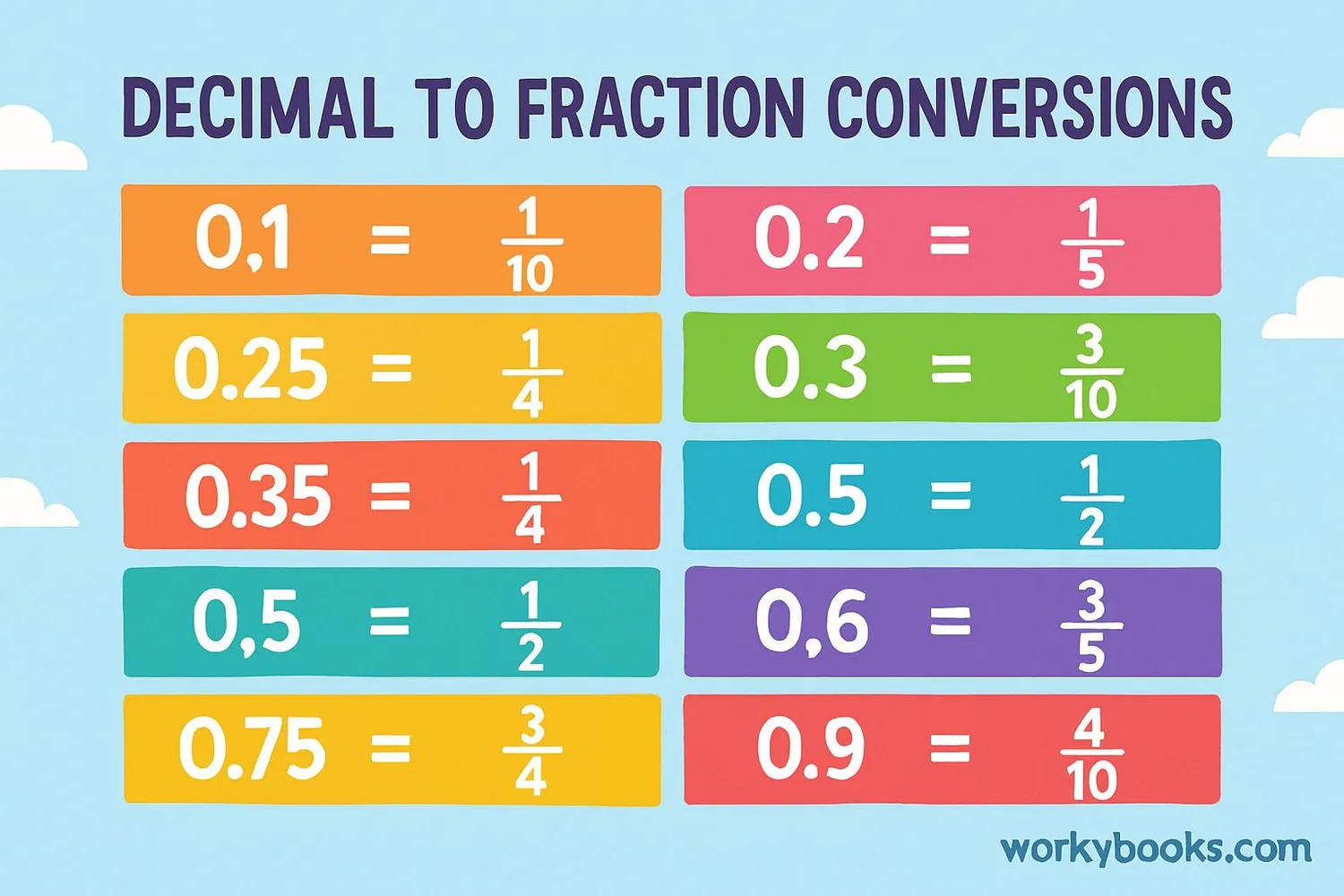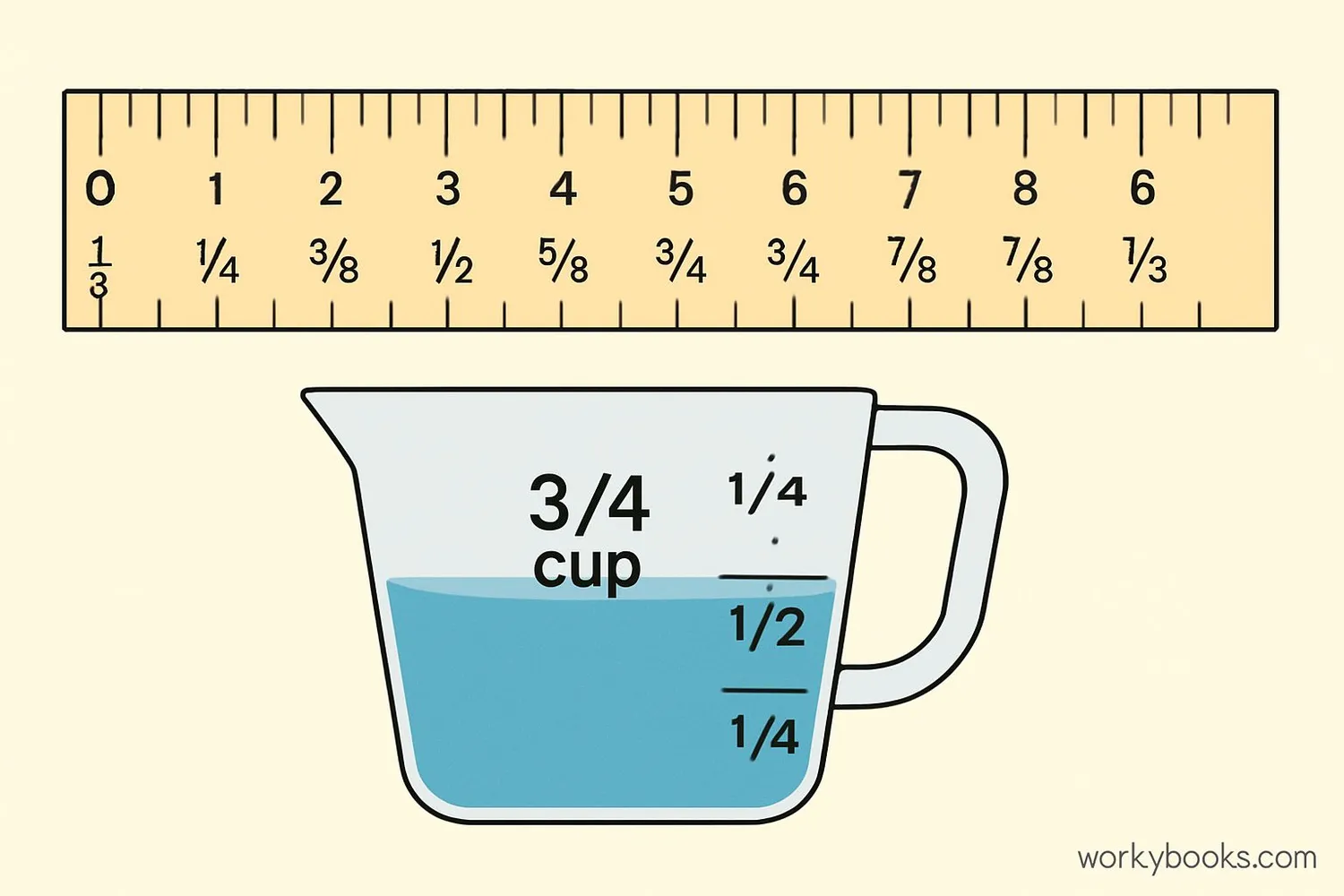Decimal to Fraction - Definition, Examples, Quiz, FAQ, Trivia
Learn to convert decimals to fractions with easy explanations and practice activities
What is Decimal to Fraction Conversion?

Decimal to fraction conversion is the process of changing a number with a decimal point into a fraction. Decimals and fractions are different ways to represent the same value. For example, 0.5 is the same as 1/2, and 0.75 is the same as 3/4.
Why is this important? Fractions often make it easier to understand parts of a whole and are commonly used in recipes, measurements, and many real-life situations. Converting decimals to fractions helps us see the relationship between numbers more clearly.
Every decimal has a denominator that is a power of 10 (10, 100, 1000, etc.). The number of digits after the decimal point tells us which power of 10 to use. For example, 0.3 has one digit after the decimal, so we use 10 as the denominator (3/10).
Key Concept
The number of digits after the decimal point determines the denominator of the fraction (10, 100, 1000, etc.).
How to Convert Decimals to Fractions

Follow these simple steps to convert any decimal to a fraction:
Write the decimal as a fraction
Place the decimal number over 1. For example, 0.75 becomes 0.75/1.
Multiply numerator and denominator
Multiply both top and bottom by 10 for every digit after the decimal point. For 0.75 (two digits), multiply by 100: (0.75 × 100)/(1 × 100) = 75/100.
Simplify the fraction
Reduce the fraction to its simplest form by dividing both numerator and denominator by their greatest common factor. For 75/100, divide by 25: 75 ÷ 25 = 3, 100 ÷ 25 = 4 → 3/4.
Conversion Formula
Where n is the number of digits after the decimal point.
Remember
Always simplify your fractions! The fraction 50/100 is correct, but 1/2 is the simplest and best form.
Decimal to Fraction Conversion Charts

These charts help you quickly find common decimal to fraction conversions:
Common Decimal to Fraction Conversions
| Decimal | Fraction | Simplified Fraction |
|---|---|---|
| 0.1 | 1/10 | 1/10 |
| 0.2 | 2/10 | 1/5 |
| 0.25 | 25/100 | 1/4 |
| 0.3 | 3/10 | 3/10 |
| 0.4 | 4/10 | 2/5 |
| 0.5 | 5/10 | 1/2 |
| 0.6 | 6/10 | 3/5 |
| 0.75 | 75/100 | 3/4 |
| 0.8 | 8/10 | 4/5 |
| 1.0 | 10/10 | 1 |
Three Decimal Place Conversions
| Decimal | Fraction | Simplified Fraction |
|---|---|---|
| 0.125 | 125/1000 | 1/8 |
| 0.25 | 250/1000 | 1/4 |
| 0.375 | 375/1000 | 3/8 |
| 0.5 | 500/1000 | 1/2 |
| 0.625 | 625/1000 | 5/8 |
| 0.75 | 750/1000 | 3/4 |
| 0.875 | 875/1000 | 7/8 |
Chart Tip
Notice how decimals like 0.5, 0.25, and 0.75 correspond to halves, quarters, and three-quarters? These are especially useful to remember!
Conversion Examples

Let's practice conversion with some examples:
Example 1: Convert 0.6 to a fraction
Step 1: Write as fraction: 0.6/1
Step 2: Multiply by 10: (0.6 × 10)/(1 × 10) = 6/10
Step 3: Simplify: 6/10 = 3/5 (divide numerator and denominator by 2)
Example 2: Convert 0.125 to a fraction
Step 1: Write as fraction: 0.125/1
Step 2: Multiply by 1000 (three digits): (0.125 × 1000)/(1 × 1000) = 125/1000
Step 3: Simplify: 125/1000 = 1/8 (divide numerator and denominator by 125)
Example 3: Convert 2.25 to a mixed number
Step 1: The whole number is 2. Now convert 0.25 to fraction: 25/100 = 1/4
Step 2: Combine: 2 1/4
Example 4: Convert 0.333... (repeating decimal) to fraction
Step 1: Let x = 0.333...
Step 2: Multiply both sides by 10: 10x = 3.333...
Step 3: Subtract: 10x - x = 3.333... - 0.333... → 9x = 3
Step 4: Solve: x = 3/9 = 1/3
Conversion Tip
For repeating decimals, use algebra to create an equation that helps solve for the fraction.
Conversion Practice Quiz
Test your conversion skills with this 5-question quiz. Choose the correct answer for each question.
Frequently Asked Questions
Here are answers to common questions about decimal to fraction conversion:
Math Trivia
Discover interesting facts about decimals and fractions:
Ancient Fractions
The ancient Egyptians used fractions as early as 1800 BC, but they only used unit fractions (fractions with 1 as the numerator). They represented other fractions as sums of unit fractions.
Decimal Invention
The decimal system was developed by Persian mathematician Al-Khwarizmi in the 9th century, but it wasn't widely adopted in Europe until the 16th century when Simon Stevin popularized it.
Fraction in Nature
Many patterns in nature follow fractions. For example, the arrangement of leaves on a stem, the spirals of pinecones, and the seeds in a sunflower often follow the Fibonacci sequence, which creates fractional patterns.
Longest Decimal
The fraction 1/97 has a decimal expansion with 96 repeating digits! This is the longest possible repeating sequence for a fraction with a denominator less than 100.





